Invincible and Legendary
The history of the Soviet Union during the Great Patriottic War
July 1942 part 1
Home Front and Foreign Affairs
The history of the Soviet Union during the Great Patriottic War
July 1942 part 1
Home Front and Foreign Affairs
By mid July the Axis have occupied just shy of 15% of the major cities in the Soivet Union. With the current state of the country in mind it is estimated the Soviets can suffer occupation of 78% of their cities before surrendering. (gameplay note: the Great Patriottic War decision that gives 3500 free manpower can be fired at 20% surrender progress)
A quick re-organisation behind the lines occurs on the 13th as the old formations of the 6th Mechanised Corps are merged with other mechanised forces and a new 6th Mechanised Corps is formed with 4 fresh motorised infantry divisions. Once organised these troops will bolster the mobile reserve behind the Baltic and Polish Fronts.
Middle East
The British position in the Middle East continues to deteriorate as Axis forces close in on the Suez Canal from 2 sides. Italian forces have been halted and slightly pushed back around El Alamein, but more and more Axis forces pour down into the region via the Balkans and Turkey. The Axis have occupied northern Iraq and entered the Sinai, cutting the communication lines between Egypt and Iraq. The British are moving reinforcements in the form of the Army of India to shore up defences in Iraq, though it remains to be seen wether this will be enough to succesfully defend Bagdad.
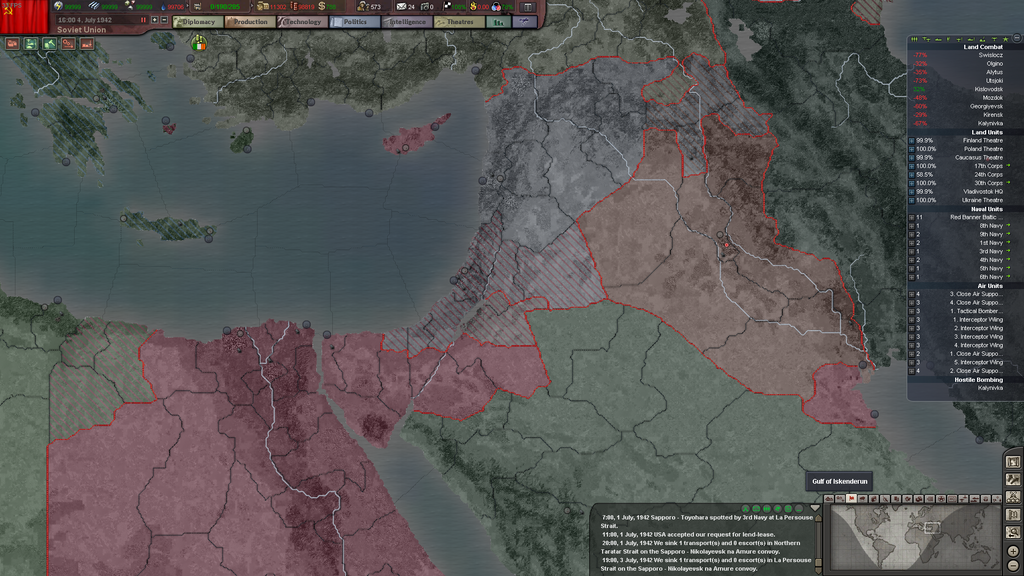
Baltic Front
The Germans have massed heavy armour south of Kaunas and begin another offensive against the Soviet infantry forces entrenhed behind the Memel river. Though the defenders lack the heavy antitank weapons needed to counter 2 divisions of German heavy tanks, the river provides some protection and the battle rages on for 4 bloody days. The Soviet counterattack against Jurbarkas succeeds in driving the Germans back on the 7th and re-establish defensive positions on the Memel. A German counterattack is halted and between the 2 battles 330 Soviet and 950 Germans died, mostly due to local Soviet armour superiority. German armour continues to push north along the coast from Memel, in spite of fierce naval bombardment by the Red Banner Baltic Fleet. Göring personally orders Stuka dive bombers to drive off the Soviet fleet, which they do with repeated air attacks on the 8th of July. The Soviet fleet retreats to Leningrad and requests for air cover are made, though wether the Red Airforce can answer these calls is questionable.
Taurage is attacked again, this time by the Hungarian army, but the offensive soon grinds to a halt against Soviet defences. The battle lasts until the 8th and claims 560 Soviet and 1100 Hungarian lives. Several German offensives are launched in the region of Wolkowysk and the southern bend of the Memel river. In Mosty, Soviet infantry and heavy tanks stop a German corps trying to establish a bridgehead over the river, losing 660 men and killing 1350.
German heavy tank forces have more success further north. They attack Alytus with ample infantry and air support and force the Memel after several days of bloody fighting. Devastating artillery barrages and air raids preceded the German armoured onslaught and 3100 Soviet and 2650 German dead are left behind on the riverbanks as Soviet infantry forces fall back and regroup.
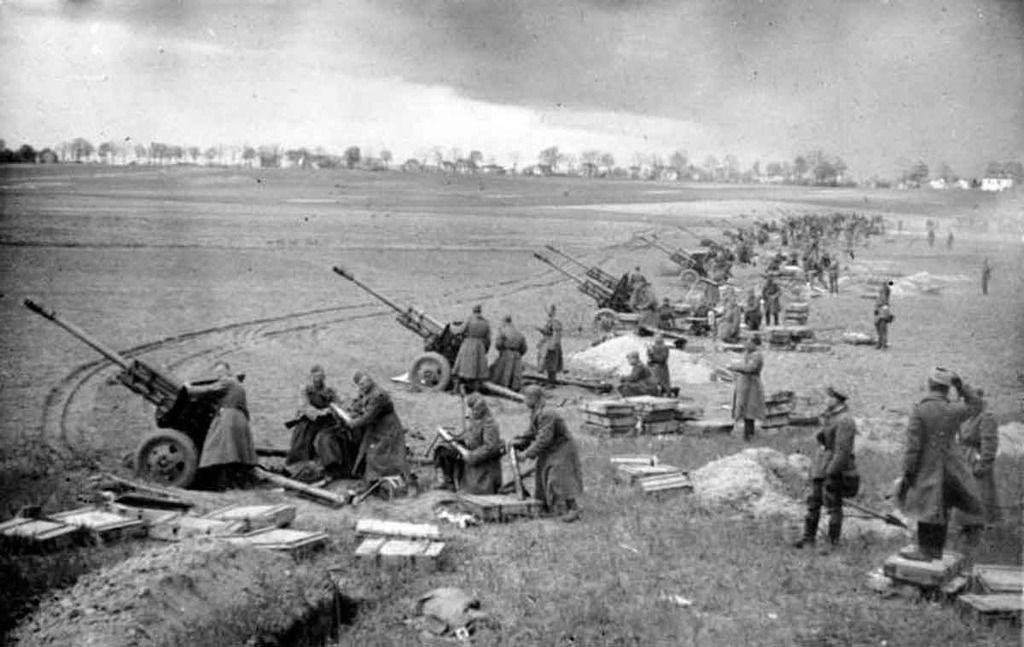
Soviet artillery batteries prepare to shell advancing German forces as they cross the Memel at Alytus
Further north another bloody battle is fought at Taurage as the Germans once again cross the Memel in force. Though Soviet casualties are only 1000 compared to 1800 German dead, the city is once again abandoned on the 12th in the face of superior German air power. But as Soviet forces hold firm in the adjacent Rietavas sector, killing 1250 attacking Germans whilst losing 860 of their own, Soviet lines do not yet collapse. The simultaneous attack at Palanga is also narrowly fought off by Red Army infantry and armour the next day, resulting in another 1600 Soviet and 1300 German dead. With the Luftwaffe reigning supreme it looks to be a matter of time before Lithuania will have to be abandoned by the Soviet Army once again.
Polish Front
German forces have attacked the southern end of the Memel river at Mosty against entrenched Soviet infantry backed by heavy armour. Despite heavy air support, the attack soon bogs down in front of the Soviet lines and suffers heavy losses as 400 Soviet and 1600 German troops perish on the riverbanks.
Fighting around Brest-Litovsk also continues as Soviet infantry forces retake the town of Kobryn, east of the city on the 4th of July. Their aim is to relief the pressure on Swislocz, which is under attack from 3 directions. This is accomplished the following day as the Germans pull back, leaving 1900 Soviet and 2000 German dead behind. But defensive positions in Swislocz are crumbling, the decision is made to fall back to the now well-entrenched reserve line some 30 km to the east. To this end, Kobryn is abandoned to a German attack on the 8th, though not without 280 Soviet and 950 German casualties in the final skirmishes, on top of 360 Soviet and 900 Slovakian dead in Swislocz. The exhausted Soviet divisions are ordered to fall back on their own lines and a crack Red Guard corps is ordered forward alongside some light armour in an attempt to plug the gap.

Backed by the German, Hungarian and Slovakian airforces the Romanian army launches another attack against Kamien Koszyrski. After more than half a year of fighting in the area, the entire city has been ruined and strong defensive positions are scattered everywhere. Soviet artillery batteries have the entire sector presighted and decimate the entire first regiment of the assault, forcing the other Romanian forces to fall back again.
To the north, another massive German offensive against Wolkowysk is underway since the 7th. German air raids and flanking attacks slowly but steadily break line after line of Soviet defences and by nightfall on the 10th the Red Army retreats from the ruined city, leaving 3700 Soviet and 4200 German and Romanian dead in their wake.
The main battle raging just east of Brest-Litovsk ends on the 11th as Soviet infantry abandon Dywin to the Germans once again after losing 3000 men and killing 2600 Germans in a week-long engagement. Other divisions have prepared new defences east of the city and reinforcements are en route from the north to prevent any risk of an Axis breakthrough.
Ukranian Front
Red Army counterattacks against the recently occupied city of Stryzhavka end in disaster on the 2nd of July. Despite a 3-pronged attack against the German positions and a 3:1 advantage in men, the Red Army is forced to retreat with heavy losses. The Soviets lost 3550 men against 1250 German dead.
A bit further to the north, on the front between Krzemieniec and Kyiv, Red Army Mechanised Corps are sent into action to bring a combinend German-Hungarian offensive against Novohrad Volynskyi to an end. The battle was hard-fought, with the Germans deploying their fearsome Tiger model heavy tanks on the front once again, but in the end the Hungarians are forced back with heavy casualties. Readers may recognize several city names from previous chapters on the map below, such as Tarnopol (still in Soviet hands from where the 53 attack is coming), Krzemieniec and Polonne (both German-occupied).

Now that the Germans outflanked the Dniester river at its northern end around Letyshiv, their forces attempt to hit the defenders in the flank with an attack against Vinnytsya. Soviet armour inflicts terrible losses on the lightly armed Hungarian infantry as they advance against the Soviet defenders before the attack bogs down and is called off in the early hours of the 3rd. The presence of the Soviet 9th Tank Division was critical as they decimated several Hungarian battalions and crushed the attack. 420 Soviet and 1650 Hungarian troops fell in the battle for the devastated town.
North of Vinnytsya the Germans capture the ruined town of Kalynivka after fierce fighting on the 6th. Decimated Soviet infantry and motorised units fall back from the ruins which claimed another 1300 Soviet and 2200 German and Hungarian lives. The Axis are slowly but surely outflanking the Ukranian Front's defensive line and clearly aim to push towards Kyiv, something they try for the first time during the next week. After 5 days of fighting around Vinnytsya the German attack breaks against the fortified lines of the Soviet 9th Tank Division, having lost 700 men to 450 defenders’ casualties.
Caucasus Front
A German attack against Uchkulan, on the west flank of the Caucasus Front is halted by 3 Soviet divisions on the 1st of July at the cost of 200 Soviet and 700 German dead. The situation on the eastern side is worse as more German armoured formations have forced their way across the Térek river and slowly but steadily force the Red Army back. German attacks in the central mountain passes are held up by entrenched Soviet divisions in the mountain passes and a Romanian offensive suffer heavy losses for no gain at the end of the Térek river line.
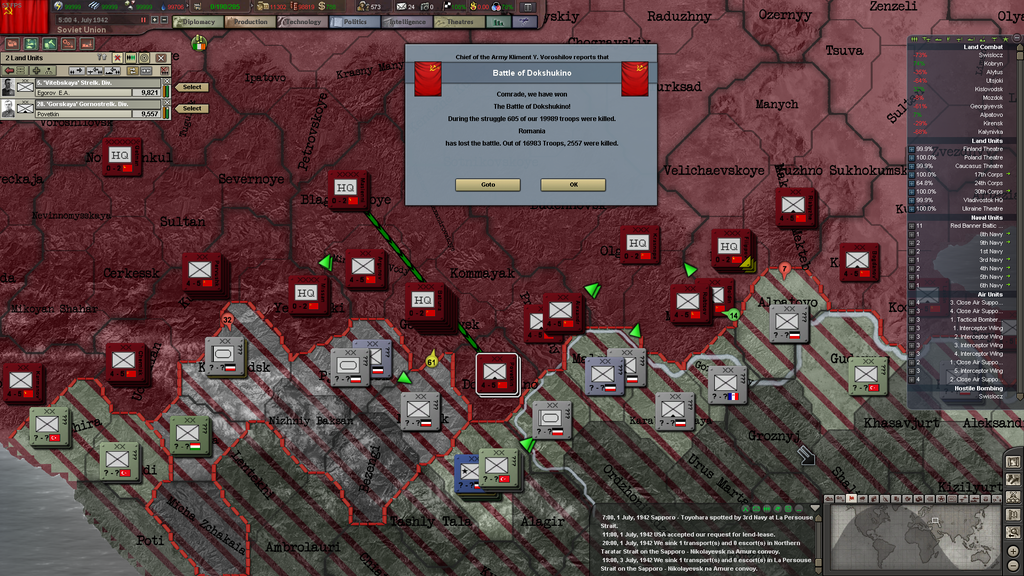
East of Dokshukino the Germans send mountain infantry to attack Mozdok, behind the Térek. The battle is short but fierce as 900 German mountaineers are cut down in the passes against 400 Soviet mountaineer casualties. But with German tanks having forced their way across the river to the east of the town, its fate hangs in the balance.
After a German attack on Georgiyevsk in the western Caucasus is fought off 2 days later with around a thousand dead each, the western part of the Caucasus calms down once again, though fighting continues in the east around the Térek. 2 Soviet divisions inflict heavy losses on a single German mountaineer division attacking across the river on the 8th as 400 Soviet and 1500 German troops die in the pointless battle. 3 days later the last German bridgehead north of the river falls as the Soviet 37th (mountain) Corps forces German armoured forces back to the south bank, killing 775 Germans and losing 400 men themselves.
Soviet mountaineer divisions attempt to dislodge German heavy armour in the western Caucasus and attack a combined German-Romanian-Turkish army near Kislovodsk. Infantry, mountaineers and armour clash with German heavy tanks and various infantry forces in the mountains and Hungarian infantry launch a flanking counterattack. After days of brutal mountain combat the Red Army calls off the attack. Though the objective of weakening the German heavy tank formation is achieved, the cost is high as 3000 Soviet soldier lie dead alongside 2000 Axis.
Far Eastern Front
Japanese forces continue their slow advance into Siberia and 2 infantry divisions push a single Soviet division out of Kirensk on the 10th, seizing the northern coast of the Baikal Lake. Soviet divisions on the northern end of the front continue their withdrawal westward as 33rd Corps covers the retreat by counterattacking a Japanese division in Artemovskij and forming a screening force on the north bank of the Lena river. With these forces in place the 100th, 193rd and 195th infantry divisions are ordered to fall back 2 days later, in an attempt to form a new defensive line along the Lena.
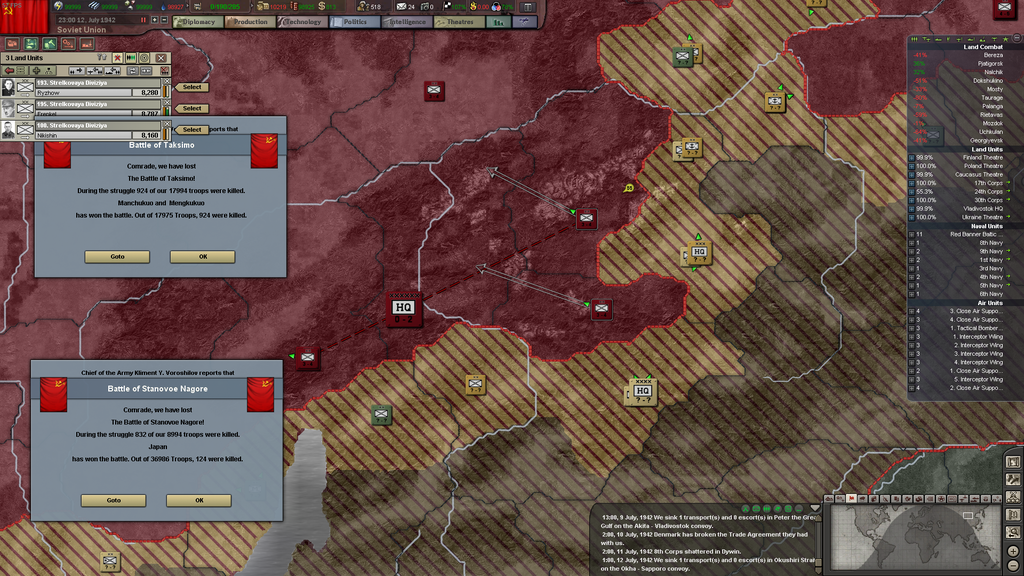
Persia

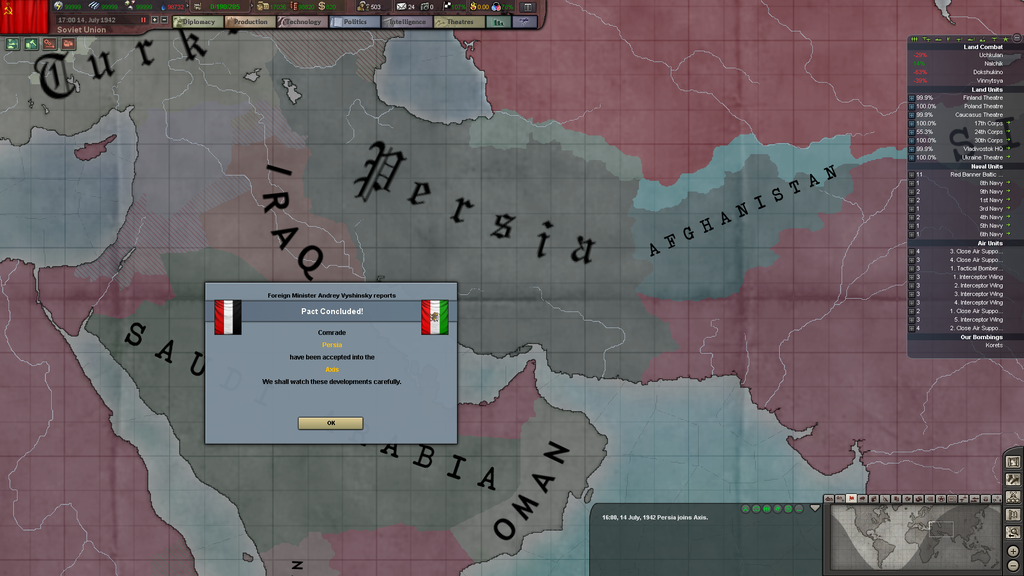
Last edited:

